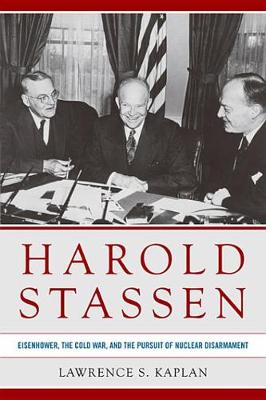Studies in Conflict, Diplomacy, and Peace
2 total works
Harold Stassen (1907-2001) garnered accolades as the thirty-one-year-old "boy wonder" governor of Minnesota and quickly assumed a national role as aide to Admiral William Halsey Jr. during World War II. When Dwight D. Eisenhower was elected in 1952, Stassen was named director of the Mutual Security Administration and then became the president's special assistant for disarmament. In this position, Stassen had the power to profoundly shape the country's foreign policy and became influential in early Cold War policy discussions about the limits and uses of conventional and nuclear weapons. In this nuanced biography, Lawrence S. Kaplan demonstrates that Stassen's role in Eisenhower's White House deserves more analysis than it has received from scholars. Stassen came to Washington advocating the total elimination of nuclear weapons, but he quickly came to recognize that this would not happen. He refocused his efforts, working for greater international transparency and communication. The liberal internationalism that Stassen espoused became embedded in Cold War policy for decades, and he consistently provided a voice for peace in an increasingly hawkish national security establishment. Stassen, in many ways, was his own worst enemy; his ambition and ego undermined his efforts and clouded his vision. His feuds with Secretary of State John Foster Dulles were legendary, and while Dulles often prevailed in the meeting room, Stassen's vision of nuclear restraint was one that Eisenhower shared. Kaplan's study provides a new perspective on nuclear disarmament during a critical period in US history and sheds light on Eisenhower's approach to international relations.
The United States has looked inward throughout most of its history, preferring to avoid "foreign entanglements," as George Washington famously advised. After World War II, however, Americans became more inclined to break with the past and take a prominent place on the world stage. Much has been written about the influential figures who stood at the center of this transformation, but remarkably little attention has been paid to Arthur H. Vandenberg (1884-1951), who played a crucial role in moving the nation from its isolationist past to an internationalist future. Vandenberg served as a U.S. senator from Michigan from 1928 to 1951 and was known in his early career for his fervent anti-interventionism. After 1945, he became heavily involved in the establishment of the United Nations and was a key player in the development of NATO. As chairman of the Senate Foreign Relations Committee during 1947 and 1948, Vandenberg helped rally support for President Truman's foreign policy - including the Marshall Plan - and his leadership contributed to a short-lived era of congressional bipartisanship regarding international relations. In The Conversion of Senator Arthur H. Vandenberg, Lawrence S. Kaplan offers the first critical biography of the distinguished statesman. He demonstrates how Vandenberg's story provides a window on the political and cultural changes taking place in America as the country assumed a radically different role in the world, and makes a seminal contribution to the history of U.S. foreign policy during the initial years of the Cold War.

